Sunflower Whole Wheat Sourdough

For those of you who wish to add more whole grains to your bread, but are hesitant to go 100%, try this blended flour loaf. It has freshly ground white whole wheat and white bread flour. There is a bit more of the whole wheat than the white, unless you use whole wheat sourdough, then the amount of wheat is even higher.
When working with whole grain flour keep in mind that all flour is different. This formula was made with my flour, which is an organic white whole wheat. I like using white whole wheat because the flavor is milder than the darker red berry whole wheat. It even looks lighter, so those who don’t like darker breads might like this bread (I’m thinking kiddos).
Whole grain flour is thirsty. If your flour usually seems to take a lot of water and the dough seems a bit stiff (it should be sticky and easy to move around) then don’t hesitate to add a bit of water each time you fold until it feels right to you. As the dough ferments, it naturally gets less sticky and easier to handle.

When I grind grains for flour, I grind it as fine as I can because the finer the flour, the easier it is for the gluten to bond. The coarser whole grain flour has a harder time getting the gluten to bond and so the bread will be heavier and flatter, it won’t rise as much. However, whole grain breads don’t attain the loft of white loaves, you just have to expect that.
Even though I grind my own wheat berries, you can use a nice bag of whole wheat flour from the store. Just check the dates on it to make sure it’s fresh. If it feels a bit coarse to you, then sift it to remove some of the bran. Or use more white flour and less whole wheat flour.
For whole grain breads, I like to use a young vigorous starter. For this formula, I start with about 100 grams of starter, then feed it 250 grams of flour and 250 grams of water. After about 4 hours at 70ish F/21ish C I use it in my dough. Older starter is weak and the gluten has broken down. Use a fresh young starter and you will add more strength to your dough. I also use a larger amount of starter to the dough than usual so the final dough ferments quickly and doesn’t take too long. I’m trying to keep the gluten strong. Stronger gluten, higher loaf.
This formula will make four large loaves, enough to eat, freeze and share. If you want to make less then halve the formula.
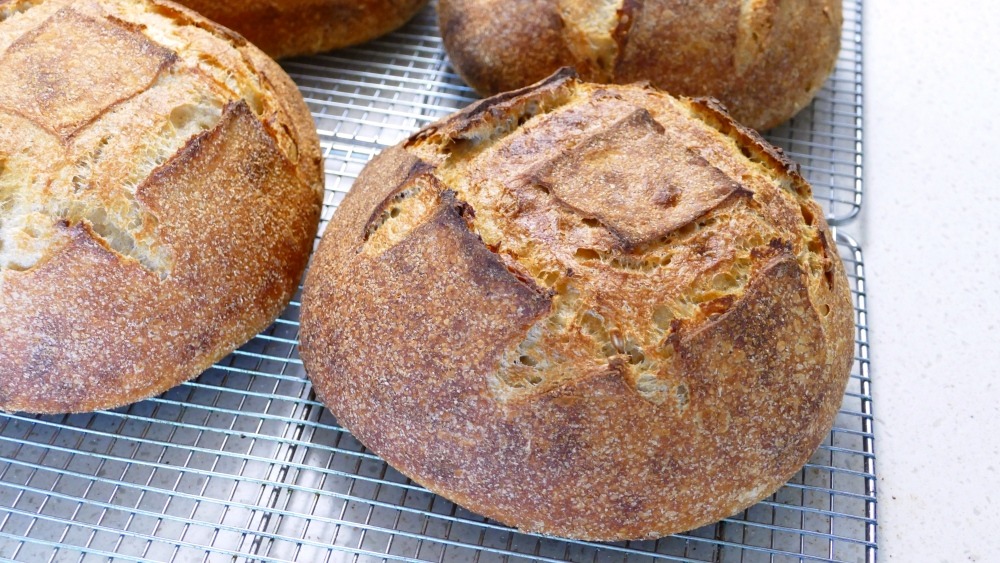
First toast your sunflower seeds and set them aside to cool.
I used 100 grams of raw sunflower seeds, placed them in a dry skillet and toasted them on a medium high burner, stirring to keep from burning. Watch them carefully and take them off before you think they're ready as they will continue to toast in the pan once you remove them from the heat. Allow to cool.
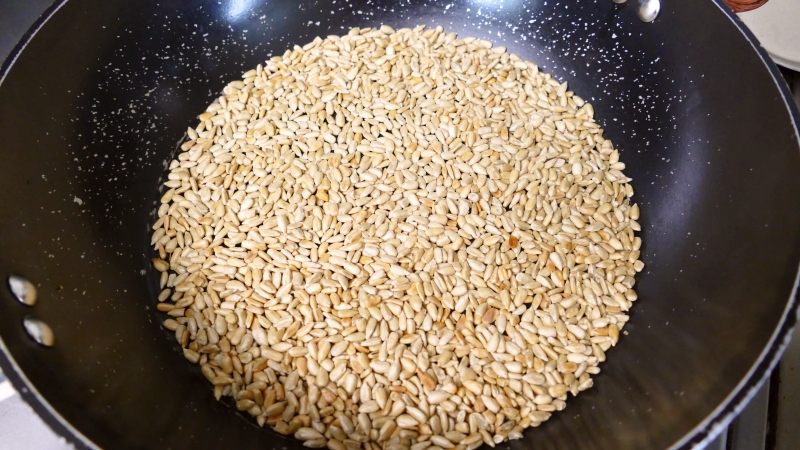
Using a dough trough or container, add 1235 grams of water and your sourdough. Then stir. Next add 960 grams of freshly ground white whole wheat (or regular whole wheat). I ground my grain very fine, so that the gluten binds better. The coarser the grain, the more difficult it is for the gluten to bind. Stir the flour into the wet ingredients.
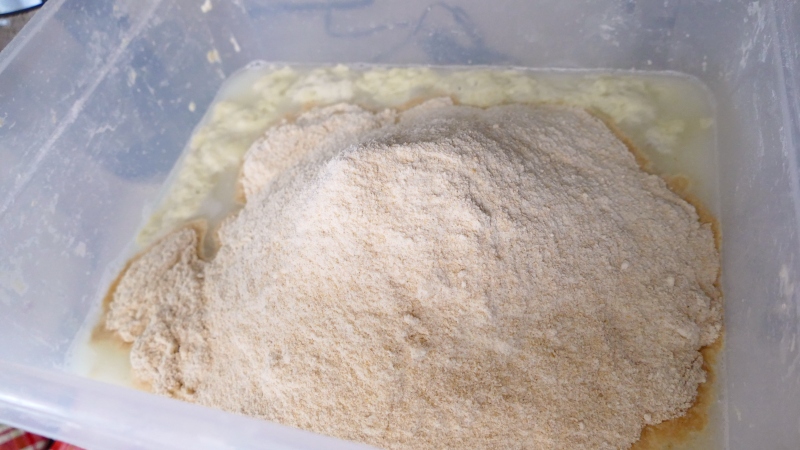
Now add 600 grams of white bread flour (high protein flour) and 35 grams of sea salt. Stir these ingredients using your hands or dough mixer if you're using one.
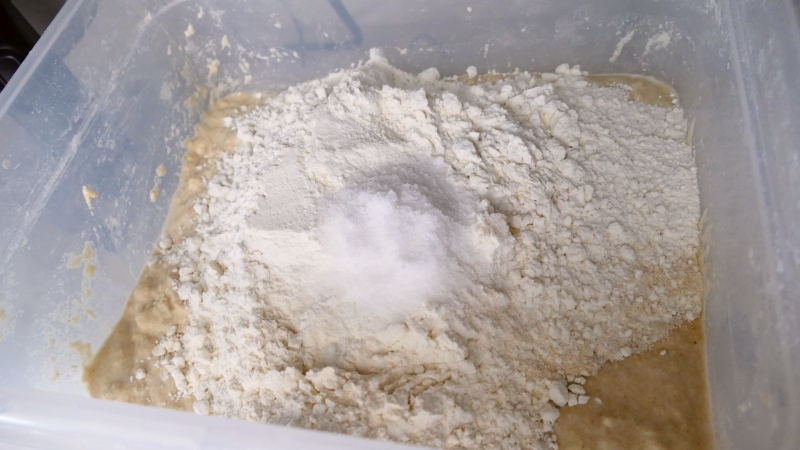
At this point your dough will look ragged and uneven. It will be around 75-80F/23-26C. Cover the dough with a lid or plastic wrap and allow it to sit for 45 minutes. Mixing was finished at 4:30 pm.
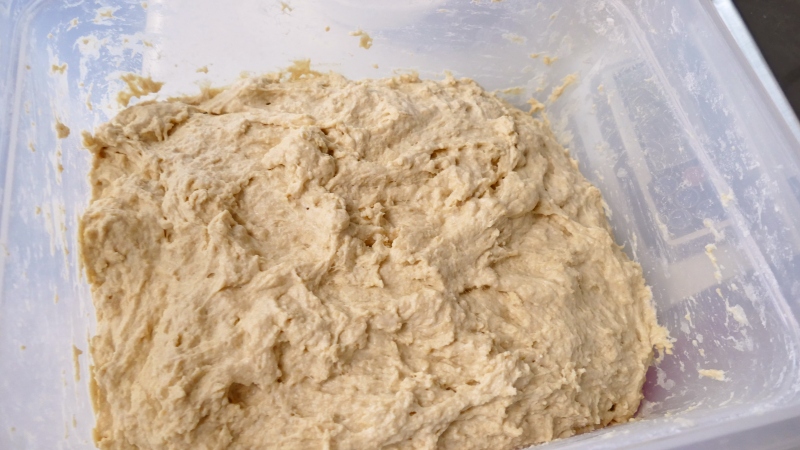
Once the 45 minutes is up (around 5:15 pm), uncover the dough and add the sunflower seeds. Fold your dough while at the same time folding in the sunflower seeds. You can do a regular fold, no need to worry about the seeds being incorporated as they will distribute during future folds. Tip: I wet my hands before folding dough.
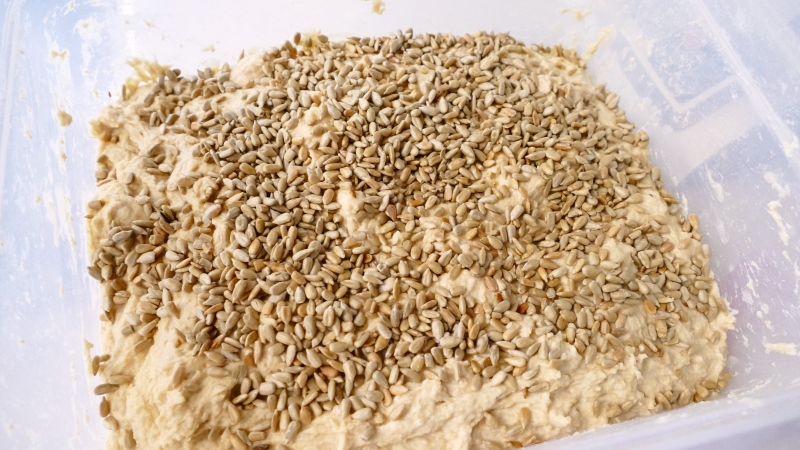
After another 45 minutes (around 6:00 pm), fold your dough again. Cover the dough each time afterwards and allow it to set until the next fold.
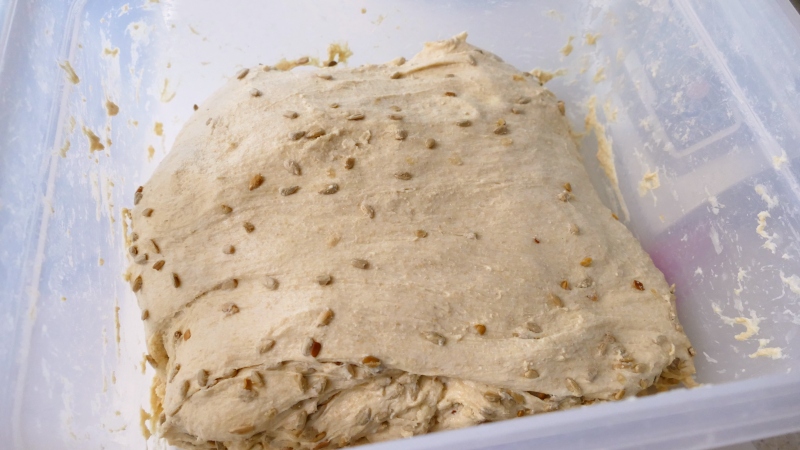
After another 45 minutes (about 6:45 pm) fold the dough one more time and then allow it to set for 45 -60 minutes until 7:30 -7:45 pm). Divide your dough into four pieces around 850 grams each. Then shape your dough.
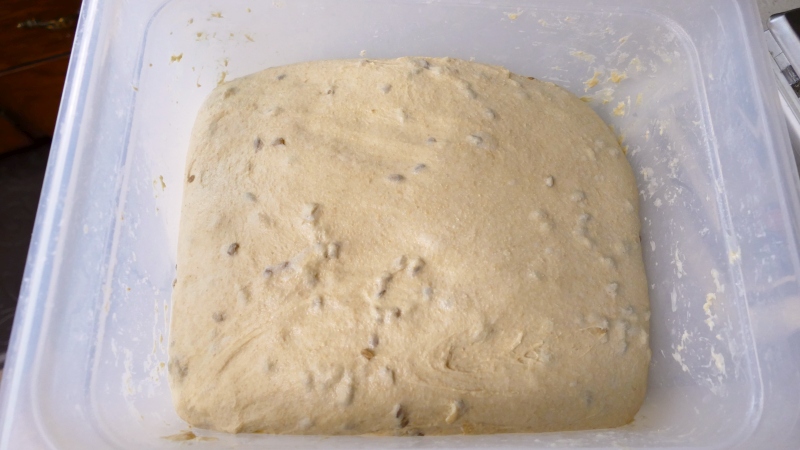
Shape the dough, be gentle, do not tear the gluten while shaping. Then dust the top of the dough lightly with whole wheat flour and place upside-down in an 8.5 - 9" floured banneton.
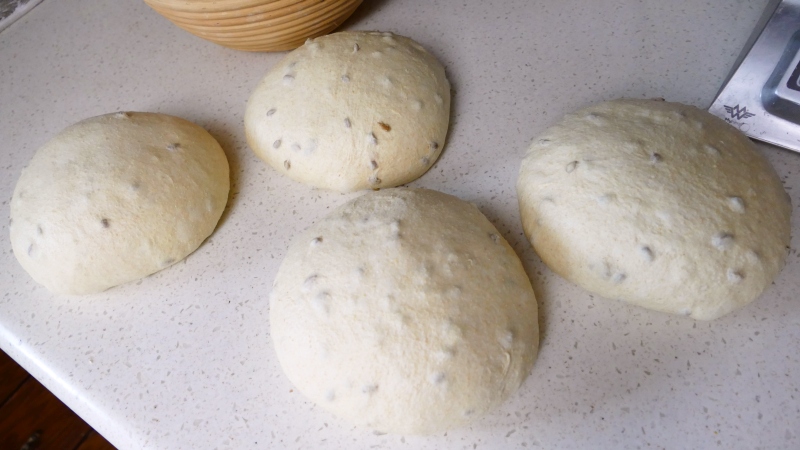
Sprinkle more flour on the top of the dough (bottom of the loaf) to keep it from sticking to the plastic cover and cover the loaves with plastic bags. Allow loaves to set at room temperature (70F/21C) for 30 minutes and then refrigerate overnight for 10-12 hours.
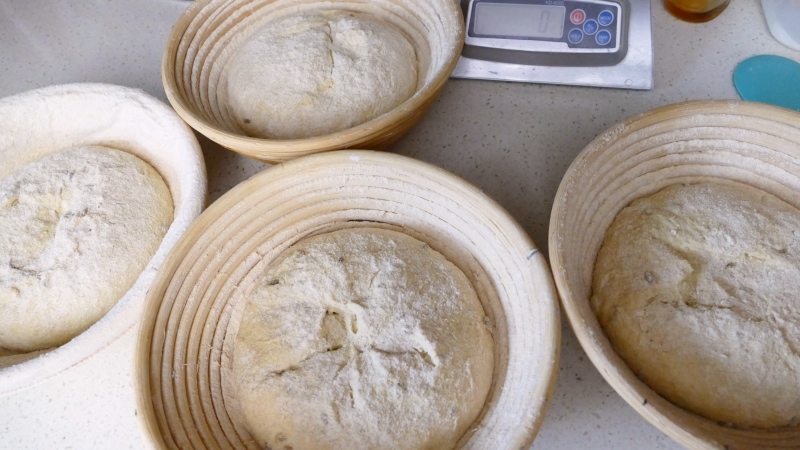
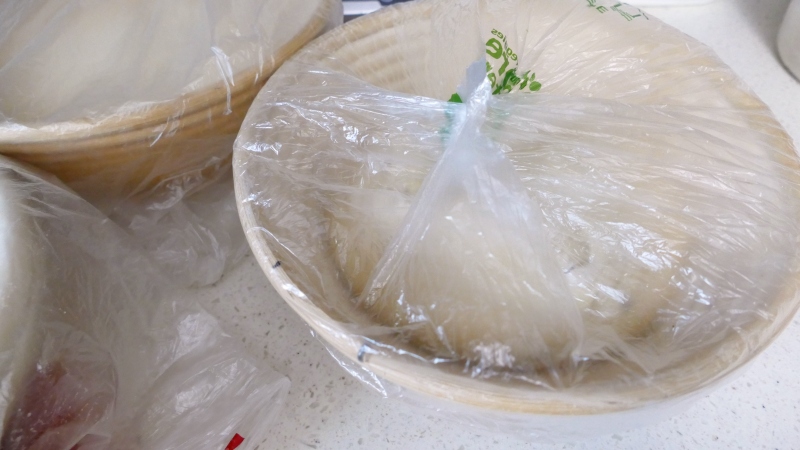
Next morning take out the loaves one at a time, staggering them so they are not all ready to go into the oven at the same time. If you can bake them all at the same time, take them all out at the same time. If you bake two loaves at a time, stagger by taking out two loaves at a time etc.
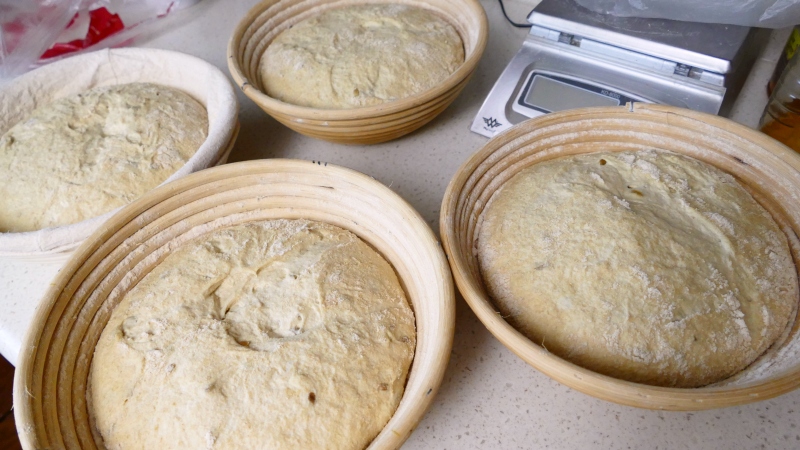
Pre-heat your oven and oven stone thoroughly (mine takes one hour) to 470F/243C. When the dough is ready (proofed and ready to bake), score your loaf then spray it with water and bake it covered (like in a Dutch oven or whatever set up you use to get steam).
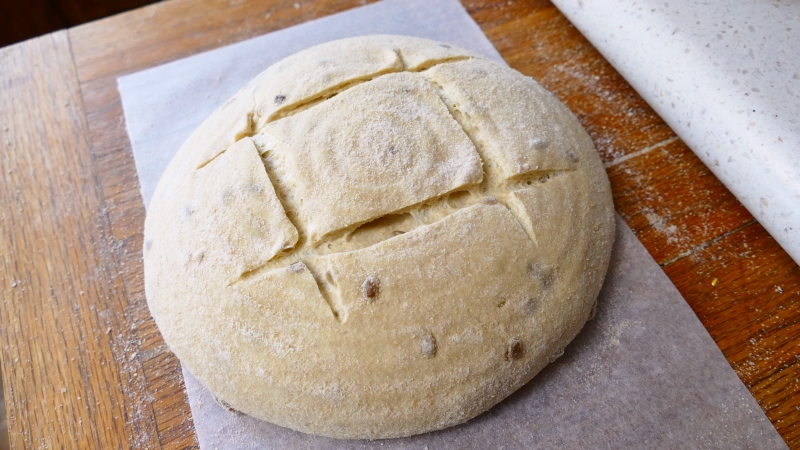
I bake for half of the bake with a cover for steam and the other half of the bake is done without a cover, so the crust can crisp up and brown. Usually each part of the bake takes around 17 minutes, so 34-35 minutes total. You can bake longer if your crust needs more browning. Bake until you get an interior temperature of at least 205F/96C. Then remove your loaf and set up to bake the next loaf. Put your finished loaf on a cooling grate to cool.
Allow the finished loaves to cool completely before slicing and serving. Enjoy!
Note: I like to bake four loaves at a time so I can freeze some and give some away. That way you don't have to bake as often.
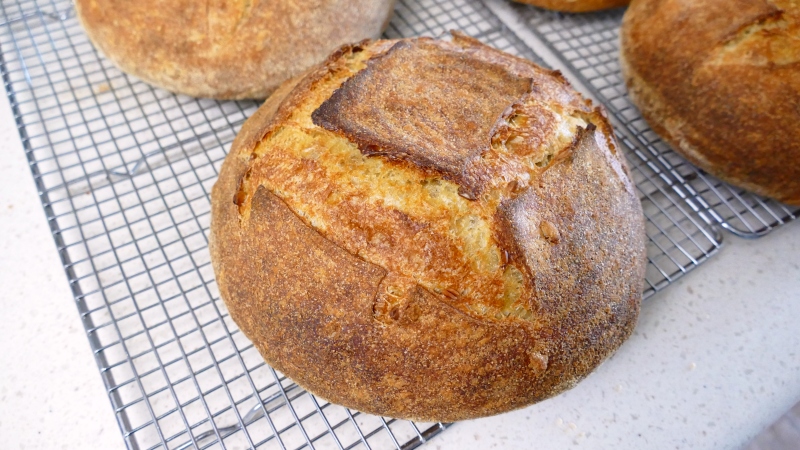
Ingredients
Directions
First toast your sunflower seeds and set them aside to cool.
I used 100 grams of raw sunflower seeds, placed them in a dry skillet and toasted them on a medium high burner, stirring to keep from burning. Watch them carefully and take them off before you think they're ready as they will continue to toast in the pan once you remove them from the heat. Allow to cool.

Using a dough trough or container, add 1235 grams of water and your sourdough. Then stir. Next add 960 grams of freshly ground white whole wheat (or regular whole wheat). I ground my grain very fine, so that the gluten binds better. The coarser the grain, the more difficult it is for the gluten to bind. Stir the flour into the wet ingredients.

Now add 600 grams of white bread flour (high protein flour) and 35 grams of sea salt. Stir these ingredients using your hands or dough mixer if you're using one.

At this point your dough will look ragged and uneven. It will be around 75-80F/23-26C. Cover the dough with a lid or plastic wrap and allow it to sit for 45 minutes. Mixing was finished at 4:30 pm.

Once the 45 minutes is up (around 5:15 pm), uncover the dough and add the sunflower seeds. Fold your dough while at the same time folding in the sunflower seeds. You can do a regular fold, no need to worry about the seeds being incorporated as they will distribute during future folds. Tip: I wet my hands before folding dough.

After another 45 minutes (around 6:00 pm), fold your dough again. Cover the dough each time afterwards and allow it to set until the next fold.

After another 45 minutes (about 6:45 pm) fold the dough one more time and then allow it to set for 45 -60 minutes until 7:30 -7:45 pm). Divide your dough into four pieces around 850 grams each. Then shape your dough.

Shape the dough, be gentle, do not tear the gluten while shaping. Then dust the top of the dough lightly with whole wheat flour and place upside-down in an 8.5 - 9" floured banneton.

Sprinkle more flour on the top of the dough (bottom of the loaf) to keep it from sticking to the plastic cover and cover the loaves with plastic bags. Allow loaves to set at room temperature (70F/21C) for 30 minutes and then refrigerate overnight for 10-12 hours.


Next morning take out the loaves one at a time, staggering them so they are not all ready to go into the oven at the same time. If you can bake them all at the same time, take them all out at the same time. If you bake two loaves at a time, stagger by taking out two loaves at a time etc.

Pre-heat your oven and oven stone thoroughly (mine takes one hour) to 470F/243C. When the dough is ready (proofed and ready to bake), score your loaf then spray it with water and bake it covered (like in a Dutch oven or whatever set up you use to get steam).

I bake for half of the bake with a cover for steam and the other half of the bake is done without a cover, so the crust can crisp up and brown. Usually each part of the bake takes around 17 minutes, so 34-35 minutes total. You can bake longer if your crust needs more browning. Bake until you get an interior temperature of at least 205F/96C. Then remove your loaf and set up to bake the next loaf. Put your finished loaf on a cooling grate to cool.
Allow the finished loaves to cool completely before slicing and serving. Enjoy!
Note: I like to bake four loaves at a time so I can freeze some and give some away. That way you don't have to bake as often.

Notes

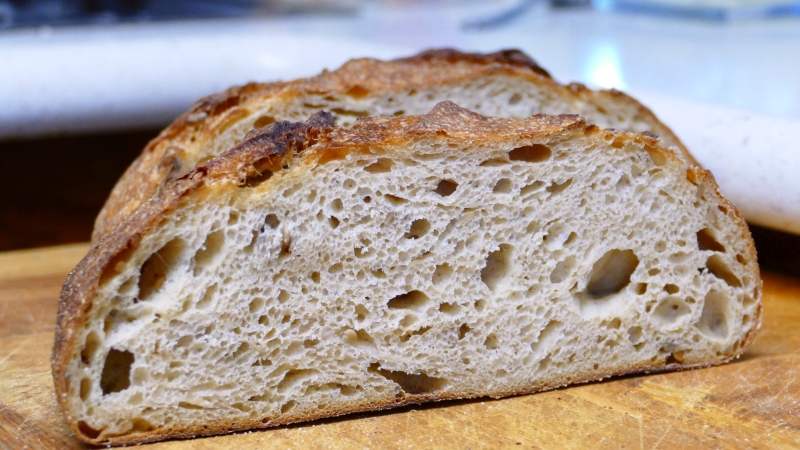
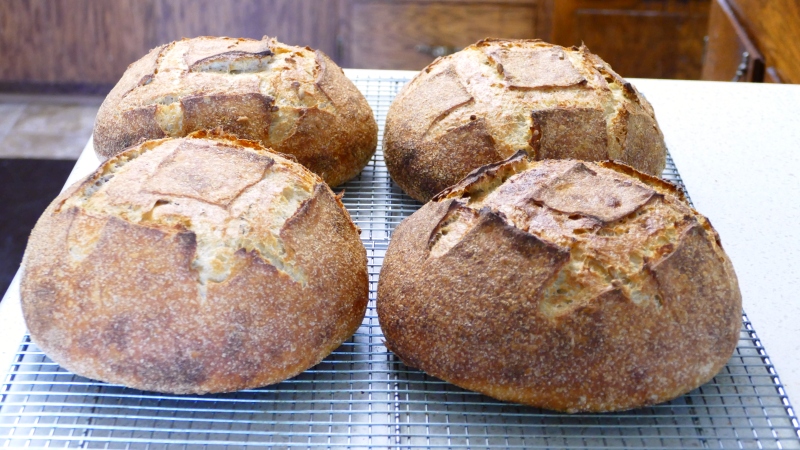

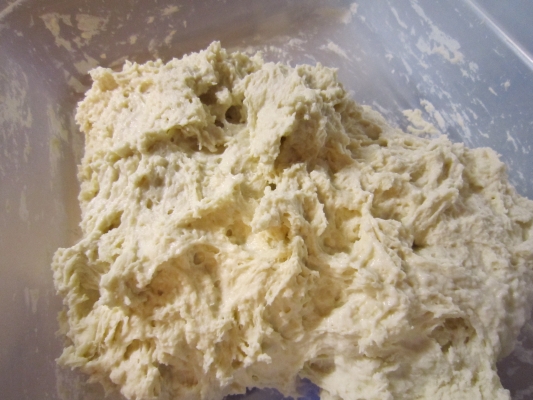
125g per loaf, that is.
Excellent formula. Made a two loaf batch that sprang beautifully, notwithstanding the high percentage of whole grain. Using 125g starter at its peak definitely helps. Reduces sourdough sharpness, though. Cuts both ways, but I know a lot of people that prefer a milder flavor.
Hi Charles, I’m glad you enjoyed this bread. It’s one of my favorite formulas, I make it often.